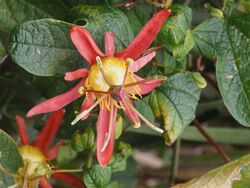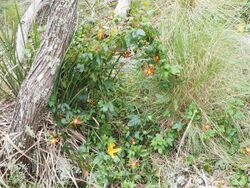Biology:Passiflora cinnabarina
| Red passionflower | |
|---|---|

| |
| Scientific classification | |
| Kingdom: | Plantae |
| Clade: | Tracheophytes |
| Clade: | Angiosperms |
| Clade: | Eudicots |
| Clade: | Rosids |
| Order: | Malpighiales |
| Family: | Passifloraceae |
| Genus: | Passiflora |
| Species: | P. cinnabarina
|
| Binomial name | |
| Passiflora cinnabarina Lindl.[1]
| |
Passiflora cinnabarina, commonly known as red passionflower,[2] is a species of flowering plant in the family Passifloraceae and is endemic to south-eastern Australia. It is a climber or scrambler with three-lobed leaves and red flowers.
Description
Passiflora cinnabarina is a glabrous climber or scrambler with slender stems up to 4 m (13 ft) long and with simple tendrils in the leaf axils. The leaves are up to 10 cm (3.9 in) long and wide with three lobes, on a petiole 20–50 mm (0.79–1.97 in) long with narrow lance-shaped stipules 3–10 mm (0.12–0.39 in) long at the base. The flowers are borne singly in leaf axils and are 4–7 cm (1.6–2.8 in) in diameter on a pedicel 3–5 cm (1.2–2.0 in) long with three thread-like bracts at the base. The sepals are 20–35 mm (0.79–1.38 in) long and keeled, red on the inside and green outside. The petals are red, 8–15 mm (0.31–0.59 in) long and the corona consists of two rings of filaments, the outer ring yellow and 6–12 mm (0.24–0.47 in) long and the inner series whitish and usually 5–6 mm (0.20–0.24 in) long. The gynophore is 20–40 mm (0.79–1.57 in) long and there are five stamens and three styles. Flowering occurs from September to January and the fruit is a green berry.[2][3][4][5]
Taxonomy
Passiflora cinnibarina was first formally described in 1855 by John Lindley in The Gardeners' Chronicle and Agricultural Gazette from plants grown from seed collected by "Lieut.-Colonel Sir Thomas Mitchell".[6][7] The specific epithet (cinnibarina) is a Latin words meaning vermilion.[8]
Distribution and habitat
Red passionflower grows along rivers in rainforest and forest, often in rocky sites and occurs from northern New South Wales, along the coast and ranges through the Australian Capital Territory to eastern Victoria. It has also become naturalised in a few sites in Tasmania.[2][3][4][9]
Ecology
The seeds of P. cinnabarina are spread by birds and possibly mammals and the plant has become an environmental weed in Victoria, Tasmania and New Zealand.[10]
Use in horticulture
This climber can be propagated from seed or from cuttings and can be grown in full sun to semi shade. It is relatively frost-tolerant but requires moist soil.[11]
References
- ↑ "Passiflora cinnabarina". Australian Plant Census. https://biodiversity.org.au/nsl/services/apc-format/display/58837.
- ↑ Jump up to: 2.0 2.1 2.2 Harden, Gwen J.. "Passiflora cinnabarina". Royal Botanic Garden Sydney. https://plantnet.rbgsyd.nsw.gov.au/cgi-bin/NSWfl.pl?page=nswfl&lvl=sp&name=Passiflora~cinnabarina.
- ↑ Jump up to: 3.0 3.1 Stajsic, Val. "Passiflora cinnibarina". Royal Botanic Gardens Victoria. https://vicflora.rbg.vic.gov.au/flora/taxon/4bcc08fc-5d60-4d69-bc36-424725377419.
- ↑ Jump up to: 4.0 4.1 Ohlsen, Daniel J.; Kodela, Phillip G. (ed.). "Passiflora cinnabarina". Australian Biological Resources Study, Department of Agriculture, Water and the Environment: Canberra. https://profiles.ala.org.au/opus/foa/profile/Passiflora%20cinnabarina.
- ↑ "Passiflora cinnabarina". Weeds of Australia. https://keyserver.lucidcentral.org/weeds/data/media/Html/passiflora_cinnabarina.htm.
- ↑ "Passiflora cinnabarina". APNI. http://id.biodiversity.org.au/instance/apni/462934. Retrieved 2 October 2021.
- ↑ Lindley, John (1855). "New Plants". The Gardeners' Chronicle and Agricultural Gazette: 724. https://www.biodiversitylibrary.org/item/100117#page/731/mode/1up. Retrieved 2 October 2021.
- ↑ William T. Stearn (1992). Botanical Latin. History, grammar, syntax, terminology and vocabulary (4th ed.). Portland, Oregon: Timber Press. p. 385.
- ↑ Jordan, Greg. "Passiflora cinnabarina". University of Tasmania. https://www.utas.edu.au/dicotkey/dicotkey/OTHERS/sPassiflora_cinnabarina.htm.
- ↑ "Red passionflower (Passiflora cinnabarina)". Tamar Valley Weed Strategy Working Group. https://www.weeds.asn.au/tasmanian-weeds/view-by-common-name/red-passionflower-passiflora-cinnabarina/.
- ↑ "Passiflora cinnabarina". Australian Native Plants Society (Australia). http://anpsa.org.au/p-cin.html.
External links
Wikidata ☰ Q12639355 entry
 |


